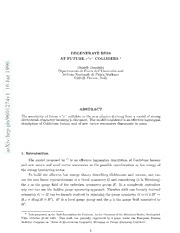Table Of ContentDEGENERATE BESS
AT FUTURE e+e− COLLIDERS *
6
9
Daniele Dominici
9
1 Dipartimento di Fisica dell’Universit`a and
Istituto Nazionale di Fisica Nucleare
n
I-50125 Firenze, Italy
a
J
6
1
1
v
4
7
2
1 ABSTRACT
0
6 The sensitivity of future e+e− colliders to the new physics deriving from a model of strong
9
electroweaksymmetrybreakingisdiscussed. Themodelconsideredisaneffectivelagrangian
/
h
description of Goldstone bosons and of new vector resonances degenerate in mass.
p
-
p
e
h
:
v
i
X
r
a
1. Introduction
The model proposed in 1) is an effective lagrangian description of Goldstone bosons
and new vector and axial vector resonances as the possible manifestation at low energy of
the strong interacting sector.
To build the effective low energy theory describing Goldstones and vectors, one can
use the non linear representations of a chiral symmetry G and considering (`a la Weinberg)
the ρ as the gauge field of the unbroken symmetry group H. In a completely equivalent
way one can use the hidden gauge symmetry approach. Theories with non linearly realized
′
symmetry G H can be linearly realized by enlarging the gauge symmetry G to G H
→ ⊗ →
′ ′
H = diag(H H ). H is a local gauge group and the ρ is the gauge field associated to
D
⊗
′
H .
* TalkpresentedattheIIndRencontresduVietnam,AttheFrontiersoftheStandardModel,Hochiminh
Ville, October 21-28 1995. This work was partially supported by a grant under the European Human
Mobility Program on ”Tests of Electroweak Symmetry Breaking at Future European Colliders”.
1
The BESS (Breaking Electroweak Symmetry Strongly) model 2) was built in this way,
usingG = SU(2) SU(2) , H = SU(2) ,andconsideringthegaugingofSU(2) U(1) .
L R V W Y
⊗ ⊗
The model with vector and axial vector resonances can be built using the same tech-
nique. In particular I will present the results for the case in which the new resonances are
degenerate in mass (neglecting the weak corrections).
This type of realization corresponds to a maximal symmetry [SU(2) SU(2)]3. After
⊗
gauging the standard SU(2) U(1) , the model describes the ordinary gauge bosons
W Y
⊗
± ± ±
W , Z and γ and, in addition, two new triplets of massive gauge bosons, L , L , R , R ,
3 3
′′
self-interacting with gauge coupling constant g . These heavy resonances, as a consequence
′′
of the chiral symmetry, are degenerate in mass M in the g limit.
→ ∞
This degenerate model has the interesting feature of allowing for a strong electroweak
resonant sector at relatively low energies, while satisfying the severe constraints from exist-
ing LEP, SLC and CDF data (see Fig. 1).
g/g"
200 800 1400 2000
0.5 0.5
0.4 0.4
0.3 0.3
0.2 0.2
0.1 0.1
0.0 0.0
200 800 1400 2000
M(GeV)
′′
Fig.1. 90%C.L.contourontheplane(M,g/g )obtainedbycomparingthevaluesoftheǫparameters
from the model with the experimental data from LEP. The allowed region is below the curve.
2. Degenerate BESS at future e+e− colliders
In this section I will discuss the sensitivity of the model at LEP2 and future e+e−
linear colliders, for different options of total centre of mass energies and luminosities.
Cross-sections and asymmetries for the channel e+e− f+f− and e+e− W+W−
→ →
in the Standard Model and in the degenerate BESS model at tree level have been stud-
ied. In the fermion channel the study is based on the following observables: the total
hadronic (µ+µ−) cross-sections σh (σµ), the forward-backward and left-right asymmetries
Ae+e−→µ+µ−, Ae+e−→¯bb, Ae+e−→µ+µ−, Ae+e−→h and Ae+e−→¯bb. At LEP2 we can add to
FB FB LR LR LR
2
the previous observables the W mass measurement.
The result of this analysis shows that LEP2 will not improve considerably the existing
limits 3). To improve these limits it is necessary to consider higher energy colliders. Two
options for a high energy e+e− collider have been studied: √s = 500 GeV (√s = 1 TeV)
with an integrated luminosity of 20fb−1 (80fb−1). In Fig. 2 a combined picture of the 90%
C.L. contours on the plane (M, g/g′′) from e+e− at two values of √s is shown. The dotted
line represents the limit from the combined unpolarized observables at √s = 500 GeV
with an integrated luminosity of 20fb−1; the dashed line is the limit from the combined
unpolarized observables at √s = 1000 GeV with an integrated luminosity of 80fb−1. As
expected increasing the energy of the collider and rescaling the integrated luminosity gives
stronger bounds on the parameter space.
In conclusion a substantial improvement with respect to the LEP bounds, even with-
out polarized beams, is obtained. Considering the polarized observables one gets a further
improvement on the limits. The WW final state does not modify the strong limits ob-
tained using the fermion final state. This is because the degenerate model has no strong
enhancement of the WW channel, present in the usual strong electroweak models.
g/g"
200 800 1400 2000
0.5 0.5
0.4 0.4
0.3 0.3
0.2 0.2
0.1 0.1
0.0 0.0
200 800 1400 2000
M(GeV)
Fig.2. 90%C.L.contourontheplane(M,g/g′′)frome+e− at√s = 500GeV withanintegrated
luminosity of 20fb−1 and √s = 1000 GeV with an integrated luminosity of 80fb−1. Allowed regions
are below the curves.
References
[1] R. Casalbuoni, A. Deandrea, S. De Curtis, D. Dominici, R. Gatto and M. Grazzini,
UGVA-DPT 1995/10-906, hep-ph/9510431.
[2] R. Casalbuoni, S. De Curtis, D. Dominici and R. Gatto, Phys. Lett. B155 (1985) 95;
3
Nucl. Phys. B282 (1987) 235.
[3] R. Casalbuoni, A. Deandrea, S. De Curtis, D. Dominici, R. Gatto and M. Grazzini,
Proceedings of the CERN Workshop on Physics at Lep2, CERN Yellow Report, to
appear in 1996.
4

